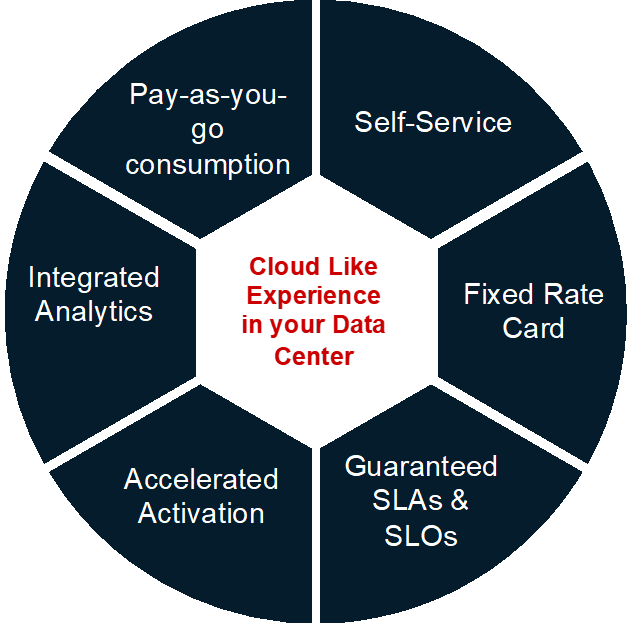A New Era of Storage: Looking Beyond the Public Cloud Model


The adoption of consumption-based storage services with pay-as-you-grow alternatives has grown rapidly during the pandemic. All projections indicate that this trend will continue into the post-pandemic landscape, with increased improvement within IT service operation. This means that new operating models will be required to ensure IT delivers services that are dynamic, cost efficient and responsive to business needs. As businesses grow, their ability to consume capacity in a flexible manner becomes even more critical.
The need for capacity is driven by many factors across all sectors. According to IDC, 64 zettabytes (ZBs) of data was created or replicated globally. The market intelligence firm also predicts that the amount of digital data created over the next five years will be greater than twice the amount of data created since the advent of digital storage.[1]
However, there remains a common theme across all companies and industries: constrained budgets. Even before COVID-19 and all the challenges it has posed, companies were struggling to stay competitive. When budgets are squeezed, focus tends to turn to resource optimization, improving return on investment, and removing the burden of sunken capital. Businesses therefore expect a more proactive approach to storage solutions so that they can become more agile, more competitive, and reduce their time-to-value with customers.
Watch my video Explosive Data Growth on a Flat IT Budget for more on this topic.
For years, cloud-based storage has been offered by public cloud providers and delivered on a consumption-based model. It manages and saves your data in a remote location, so that you don’t have to store it on a traditional storage infrastructure.
The cloud-based storage approach has many advantages. First, you do not have to carry out the administration of local storage as was done in the past. Secondly, the consumption-based model introduces cost savings: You only pay for what you are using. Likewise, it’s more affordable to buy cloud storage for a nominal fee, as opposed to buying and maintaining an on-premises storage infrastructure. Cloud-based storage also offers flexibility, scalability and ease of management through a self-service portal for simplified planning and deployment.
It is, however, held back to an extent by concerns around security, availability, compliance, migration planning, predictable cost and performance.
To achieve a wider adoption in the market, these roadblocks need to be removed. Our Storage-as-a-Service (STaaS) from Hitachi Vantara offering is provided through a cloud-based, self-service portal for ordering, implementation and invoicing storage consumption as capacity fluctuates. STaaS is a hybrid cloud-pay-as-you-grow solution that frees your business from upfront investment and resource-intensive maintenance costs. It is delivered on premises to improve security and availability, secure performance and support data migration projects. This improves IT services operation with enhanced built-in automation and consumption-based delivery models. It also opens up wider adoption in the midsize market when lead by partners and service providers.
Eventually, managed STaaS will play a key role in the data center and become the new norm going forward. All of this is part of the hybrid IT initiatives we have seen in the market, where traditional, public cloud and private cloud services blend into a unified IT service offering.
AI is the way to achieve scalable IT services using increased automation and orchestration. Many of our midmarket customers are caught in a challenging position right now. They are faced with many of the same problems we see our large enterprise customers grappling with — including mushrooming data demands, unpredictable business growth, and so on — but with smaller budgets and fewer personnel to overcome them.
How can these customers compete against cloud-based storage? STaaS with automation and analytics tools integrated with artificial intelligence (AI) and machine learning (ML) capabilities hold the answer: These tools and capabilities help to manage ever-growing storage demands more efficiently with fewer personnel, resources and less human intervention.
For more information on this challenging area, read my blog on the topic here.
Last year, we saw a change in the buying behavior of enterprise storage capacity, moving towards a consumption-based service offering. It increased from around 15% to almost 35% in some regions. We estimate that it will continue in this direction over the coming years to over 50% of all delivered storage capacity. There is a need in the market to reconsider and modernize traditional STaaS offerings. Organizations want full control over their environment, but they don’t want to operate their own data center or be forced to fit into traditional public cloud models: They want a cloud model that fits their business.

Hitachi’s STaaS is designed for organizations looking for an on-premises solution with a “public cloud like experience,” including elastic storage consumption. By providing a SaaS management interface, coupled with an on-premises private cloud storage solution, STaaS enables agility, delivers flexibility and provides transparent cloud economics without relinquishing control over your customers’ data.
Offered through the Hitachi Vantara partner ecosystem, this solution can be leveraged as part of a “cloud-first” strategy when customers’ data must stay on premises.
If you’d like to learn more about how we could support your business with STaaS, visit hitachivantara.com.
Tom Christensen is Global Technology Advisor and Executive Analyst at Hitachi Vantara.
To hear more from Tom Christensen, join us at the virtual Hitachi Social Innovation Forum on May 25-27. Register here.
[1] IDC Press Release, Data Creation and Replication Will Grow at a Faster Rate Than Installed Storage Capacity, According to the IDC Global DataSphere and StorageSphere Forecasts, March 2021.

Tom has +30 years' experience in data center modernization, from compute and data infrastructure to hybrid and multicloud, applications, DataOps and big data analytics. He writes extensively about technology and advocates for sustainability and social innovation.